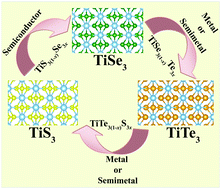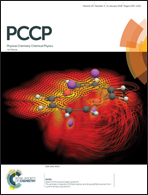Influence of chalcogen composition on the structural transition and on the electronic and optical properties of the monolayer titanium trichalcogenide ordered alloys†
Abstract
Based on first-principles spin-polarized density functional theory, we investigate the effects of chalcogen composition on the structural, electronic, and optical properties of monolayer  (where X and X′ = S, Se, Te) ordered alloys with values of x of 0, 0.167, 0.333, 0.500, 0.667, 0.833, and 1. We determine the optimized geometry for all possible substitutional adsorptions of chalcogen atoms for each x composition, and identify the energetically most stable allotropes as a function of composition. Our extensive analysis reveals that the structural and electronic properties depend on the chemical composition of the monolayers, and the band gap of TiX3 nanosheets can be tuned by adjusting the ratio of chalcogen compositions. While substitutional doping of tellurium atoms into TiS3 or TiSe3 monolayers results in a semiconductor–metal transition, the alloys remain a semiconductor under the transition from TiS3 to TiSe3 with band gaps which are very suitable for optical devices and infrared detectors. We also find that each TiS3(1−x)Se3x structure has an anisotropic dielectric function. Because of the anisotropy of the dielectric function, they can be useful materials for application in the transition metal trichalcogenide-based nanoelectronics industry in the future.
(where X and X′ = S, Se, Te) ordered alloys with values of x of 0, 0.167, 0.333, 0.500, 0.667, 0.833, and 1. We determine the optimized geometry for all possible substitutional adsorptions of chalcogen atoms for each x composition, and identify the energetically most stable allotropes as a function of composition. Our extensive analysis reveals that the structural and electronic properties depend on the chemical composition of the monolayers, and the band gap of TiX3 nanosheets can be tuned by adjusting the ratio of chalcogen compositions. While substitutional doping of tellurium atoms into TiS3 or TiSe3 monolayers results in a semiconductor–metal transition, the alloys remain a semiconductor under the transition from TiS3 to TiSe3 with band gaps which are very suitable for optical devices and infrared detectors. We also find that each TiS3(1−x)Se3x structure has an anisotropic dielectric function. Because of the anisotropy of the dielectric function, they can be useful materials for application in the transition metal trichalcogenide-based nanoelectronics industry in the future.



 Please wait while we load your content...
Please wait while we load your content...